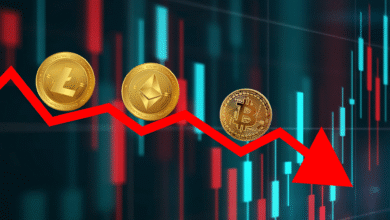
Crypto treasury companies increasingly pivot away from established digital assets like Bitcoin and Ethereum toward more speculative, fringe tokens. This strategic realignment has sparked considerable debate within the digital asset community, with industry observers raising red flags about heightened market volatility and potential systemic risks. As publicly traded companies and cryptocurrency-focused firms diversify their balance sheets with lesser-known tokens, questions about fiduciary responsibility, market manipulation, and investor protection have moved to the forefront of regulatory and industry discussions.
The transition from conservative Bitcoin holdings to experimental altcoins represents a fundamental change in how corporate treasuries approach cryptocurrency investments. What was once a cautious embrace of digital gold has evolved into a high-stakes gamble on emerging blockchain projects, decentralized finance protocols, and niche tokens with limited market capitalization. Crypto Treasury This shift reflects both the maturing cryptocurrency ecosystem and the insatiable appetite for higher yields in an increasingly competitive financial landscape. However, this aggressive pursuit of returns comes with substantial risks that could reverberate throughout the broader cryptocurrency markets and potentially impact traditional financial systems.
The Shift in Corporate Crypto Strategy
The phenomenon of corporate Bitcoin adoption began gaining momentum around 2020 when companies like MicroStrategy pioneered the concept of holding substantial cryptocurrency reserves on corporate balance sheets. Initially, these treasury strategies focused almost exclusively on Bitcoin, which was viewed as a digital store of value and a hedge against inflation. The logic was straightforward: Bitcoin’s limited supply, established market presence, and growing institutional acceptance made it a relatively conservative choice for companies willing to explore digital asset investments.
Fast forward to today, and the landscape has transformed dramatically. Crypto treasury companies are now venturing far beyond Bitcoin, allocating significant portions of their holdings to alternative cryptocurrencies with far less proven track records. These fringe tokens often represent experimental blockchain projects, governance tokens for decentralized autonomous organizations, or speculative plays on emerging cryptocurrency sectors like non-fungible tokens and metaverse platforms. The motivations driving this shift are multifaceted, ranging from the desire to capture outsized returns to strategic positioning in nascent blockchain ecosystems.
Several factors have contributed to this strategic pivot. First, Bitcoin’s maturation as an asset class has resulted in more stable but potentially lower percentage returns compared to its early years. Companies seeking exponential gains have naturally looked toward smaller market cap tokens where price movements can be more dramatic. Second, the proliferation of blockchain projects has created a vast menu of investment opportunities, each promising revolutionary technological breakthroughs and substantial returns. Third, competitive pressures among crypto treasury firms have created an environment where taking calculated risks on emerging tokens has become normalized, if not expected.
The Anatomy of Fringe Token Investments
Fringe tokens encompass a broad category of digital assets that exist outside the mainstream cryptocurrency hierarchy. Unlike Bitcoin and Ethereum, which command market capitalizations in the hundreds of billions, these tokens typically operate with far smaller trading volumes and market valuations. They might represent governance rights in decentralized finance protocols, utility tokens for specific blockchain applications, or speculative investments in projects still under development. The common denominator is their relative obscurity and unproven long-term viability.
The appeal of these assets lies in their potential for explosive growth. A token trading at fractions of a cent could theoretically deliver thousand-percent returns if the underlying project gains traction. For treasury companies managing hundreds of millions or even billions in assets, allocating even a modest percentage to such speculative positions could generate returns that significantly impact overall portfolio performance. This mathematical reality has created powerful incentives for treasury managers to explore increasingly exotic corners of the cryptocurrency universe.
However, the characteristics that make fringe tokens attractive for potential gains also make them inherently risky. These assets typically suffer from low liquidity, meaning large positions cannot be easily exited without significantly impacting market prices. Many lack transparent development teams, comprehensive auditing, or clear use cases beyond speculation. The regulatory status of numerous fringe tokens remains ambiguous, creating potential legal exposure for companies holding them. Additionally, the technical complexity of evaluating blockchain projects means that many treasury managers may lack the specialized expertise required to properly assess the risks they’re assuming.
Volatility Concerns and Market Dynamics
The migration of substantial corporate capital into fringe cryptocurrency markets has raised serious concerns about amplified market volatility. When companies with significant resources enter relatively small and illiquid markets, their buying and selling activities can dramatically influence price movements. This creates a feedback loop where corporate investment decisions can trigger cascading effects throughout interconnected cryptocurrency markets, potentially destabilizing entire sectors of the digital asset ecosystem.
Market volatility in cryptocurrency markets has always been higher than traditional financial markets, but the concentration of corporate treasury funds in narrow market segments exacerbates this tendency. A single large sale by a major treasury holder could trigger panic selling among retail investors, while coordinated buying by multiple firms could create artificial price bubbles detached from fundamental value. These dynamics are particularly concerning given the 24/7 nature of cryptocurrency trading and the absence of circuit breakers or trading halts that protect traditional markets from extreme volatility.
The interconnected nature of modern cryptocurrency markets means that instability in fringe token markets can spread to more established digital assets. Many traders use automated algorithms that respond to price movements across multiple tokens simultaneously. Additionally, the widespread use of leveraged trading in cryptocurrency markets means that sudden price swings can trigger margin calls and forced liquidations, creating cascading effects that amplify initial movements. When corporate treasuries holding significant positions in volatile tokens face pressure to liquidate, the resulting market impact can be severe and far-reaching.
Regulatory Scrutiny and Compliance Challenges
The shift toward fringe token investments by publicly traded companies has not escaped the attention of financial regulators. Securities and Exchange Commission officials and their international counterparts have expressed growing concern about the potential for market manipulation, inadequate disclosure, and systemic risk created by corporate cryptocurrency holdings. The regulatory framework governing corporate investment in digital assets remains underdeveloped, creating legal gray areas that companies are navigating with varying degrees of caution.
One primary concern involves whether certain fringe tokens should be classified as securities subject to comprehensive regulatory oversight. Many tokens that companies are adding to their treasuries have characteristics suggesting they might constitute investment contracts under securities law. If regulatory authorities determine that companies have been holding unregistered securities, the legal and financial consequences could be substantial. This uncertainty has created a challenging environment for treasury managers attempting to balance innovation with compliance.
Corporate disclosure requirements present another significant challenge. Public companies must provide shareholders with material information about their financial positions and risk exposures. However, the rapidly evolving nature of cryptocurrency markets and the complexity of evaluating fringe token holdings make comprehensive disclosure difficult. How should companies value illiquid tokens with limited price history? What constitutes adequate disclosure about the technical risks associated with experimental blockchain protocols? These questions lack clear answers, leaving companies vulnerable to shareholder litigation and regulatory enforcement actions.
Impact on Traditional Finance and Investor Confidence
The cryptocurrency treasury trend has implications extending beyond the digital asset ecosystem into traditional financial markets. Many companies pursuing aggressive fringe token strategies are publicly traded firms whose shares are held by mainstream investors, pension funds, and mutual funds. When these companies experience significant volatility in their cryptocurrency holdings, it directly impacts their stock valuations and the portfolios of traditional investors who may have limited understanding of or appetite for such risks.
This blurring of boundaries between cryptocurrency speculation and traditional corporate finance has created tension between different investor constituencies. Some shareholders embrace the potential for outsized returns from cryptocurrency investments, viewing them as necessary adaptations to a changing financial landscape. Others see reckless speculation that diverts capital from core business operations and exposes companies to unnecessary risks. This tension has manifested in shareholder resolutions, proxy battles, and public debates about appropriate corporate governance standards for cryptocurrency investments.
The potential for contagion from cryptocurrency volatility to broader financial markets represents another serious concern. As more companies allocate larger portions of their balance sheets to digital assets, the correlation between cryptocurrency prices and traditional equity markets may strengthen. A severe downturn in cryptocurrency markets could trigger write-downs that impact corporate earnings, potentially spreading financial distress beyond companies directly invested in digital assets. This systemic interconnectedness is precisely the type of risk that financial regulators are designed to monitor and mitigate.
The Role of Yield Chasing in Treasury Decisions
Understanding why crypto treasury companies are embracing fringe tokens requires examining the broader context of yield-seeking behavior in modern financial markets. Following years of low interest rates and quantitative easing by central banks, investors across all asset classes have pursued increasingly risky strategies to generate acceptable returns. This dynamic has pushed capital into venture capital, private equity, and alternative investments, with cryptocurrency representing the most extreme manifestation of this trend.
For companies whose primary business model involves holding and managing cryptocurrency assets, the pressure to deliver competitive returns is particularly acute. When Bitcoin generates modest single-digit percentage gains over a quarter, treasury managers face pressure to explain why they’re not capturing the triple-digit returns available in smaller tokens. This creates powerful organizational incentives to take risks that might not align with prudent financial management or the long-term interests of stakeholders.
The competitive dynamics among crypto treasury firms have created something resembling an arms race, where companies feel compelled to match or exceed the risk-taking of their peers. When one firm announces significant investments in emerging tokens and subsequently reports impressive gains, others face pressure to follow suit or risk appearing overly conservative. This herd behavior can drive entire sectors toward increasingly speculative positions, creating conditions ripe for market instability when sentiment inevitably shifts.
Sustainability and Risk Management
As the trend toward fringe token investments continues, questions about long-term sustainability become increasingly pressing. Can companies maintain aggressive yield-seeking strategies indefinitely, or are current approaches setting the stage for eventual corrections that could reshape the cryptocurrency treasury landscape? The answer likely depends on how various stakeholders respond to emerging risks and whether more robust risk management frameworks emerge to govern corporate cryptocurrency investments.
Some industry observers advocate for the development of best practices and industry standards that could bring greater discipline to corporate cryptocurrency holdings. These might include limits on allocation to highly speculative assets, requirements for independent valuation and auditing, or enhanced disclosure standards that provide investors with clearer visibility into treasury risks. The challenge lies in developing frameworks that preserve innovation and flexibility while protecting stakeholders from excessive risk-taking.
The role of institutional investors and traditional financial intermediaries may prove decisive in shaping how this trend evolves. As more cryptocurrency companies seek access to mainstream capital markets through public offerings or institutional investment, they will face pressure to adopt more conservative treasury practices that align with traditional financial management standards. This could create a bifurcation in the market between companies pursuing aggressive fringe token strategies and those adopting more measured approaches focused on established digital assets.
Conclusion
The pivot by crypto treasury companies toward fringe tokens represents a significant evolution in corporate cryptocurrency strategy, one that carries profound implications for market stability, investor protection, and the broader financial system. While the pursuit of higher yields through investments in emerging tokens is understandable given competitive pressures and limited returns from established cryptocurrencies, the associated risks cannot be ignored. Heightened volatility, regulatory uncertainty, potential market manipulation, and systemic contagion all present legitimate concerns that require serious attention from companies, regulators, and investors alike.
The cryptocurrency ecosystem stands at a critical juncture where the decisions made by treasury companies today will shape the industry’s credibility and long-term viability. Striking the appropriate balance between innovation and prudence will require ongoing dialogue among all stakeholders, development of more sophisticated risk management practices, and potentially new regulatory frameworks tailored to the unique challenges of digital asset markets. As this trend continues to unfold, careful monitoring and thoughtful analysis will be essential to understanding its ultimate impact on both cryptocurrency markets and the broader financial landscape.
FAQs
Q: What exactly are crypto treasury companies?
Crypto treasury companies are organizations that hold significant amounts of cryptocurrency assets on their corporate balance sheets as part of their financial strategy. These can include publicly traded firms, cryptocurrency-focused businesses, or companies that have diversified their cash holdings to include digital assets.
Q: Why are fringe tokens considered more risky than Bitcoin or Ethereum?
Fringe tokens carry a higher risk due to several factors, including lower liquidity, limited trading history, unproven technology, smaller development teams, and less regulatory clarity. Unlike Bitcoin and Ethereum, which have established track records and widespread adoption, fringe tokens often represent experimental projects that may never achieve mainstream success.
Q: How does increased volatility in fringe tokens affect the broader cryptocurrency market?
When treasury companies invest heavily in fringe tokens, their buying and selling activities can create ripple effects throughout interconnected cryptocurrency markets. Sudden price movements in smaller tokens can trigger automated trading algorithms, force margin liquidations, and shift investor sentiment across multiple assets.
Q: Are there any regulations governing how companies can invest in cryptocurrency?
The regulatory landscape for corporate cryptocurrency investments remains incomplete and varies by jurisdiction. Public companies must comply with securities laws regarding disclosure and financial reporting, but specific regulations addressing cryptocurrency holdings are still developing.
Q: What should investors consider when evaluating companies with significant cryptocurrency holdings?
Investors should carefully examine several factors, including the percentage of company assets held in cryptocurrency, the specific tokens held and their risk profiles, the company’s risk management policies, volatility in cryptocurrency holdings and its impact on financial results, regulatory compliance measures, and disclosure transparency.









